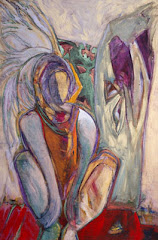 This semester has been full of many new and exciting concepts that I have never before thought about when it comes to art. I am quite surprised at how much I have actually been able to learn and retain, since I didn’t expect quite so much being that it is an online class. However, I think taking this online helped me to become my own teacher in a sense, which definitely helps to ingrain the concepts into the mind.
This semester has been full of many new and exciting concepts that I have never before thought about when it comes to art. I am quite surprised at how much I have actually been able to learn and retain, since I didn’t expect quite so much being that it is an online class. However, I think taking this online helped me to become my own teacher in a sense, which definitely helps to ingrain the concepts into the mind.I really enjoyed learning much of the terminology, because it definitely has changed my outlook and perspective regarding all things in life. A simple painting hanging on the wall is now much more complex, since I can point out things such as, media, tones, hues, line types, lighting and so much more. I like the fact that I am now able to speak about a piece of artwork with the comfort of having an actual understanding of terminology necessary to describe the work I am talking about. This class also opened my eyes to the wide variety of art forms that exist. I never really thought too much about natural art forms, such as earthworks and landscapes in the sense of art before this class. However, after learning about them and seeing the Spiral Jetty for the first time, I became intrigued. I would truly enjoy being able to see this and many other earthworks in person, whereas before I might have missed the opportunity to become knowledgeable about such amazing art forms.
My most memorable experience would definitely have to be my trip to the de Young Museum of San Francisco. It was really nice to see actual paintings, sculptures and other art forms in person, rather than simply from the text. Although I traveled to many wonderful museums in Europe this past winter, the de Young visit was an entirely new experience, since I had now learned the terminology that coincides with the artworks that were hanging before my eyes. I had gained a new appreciation for the artworks, through an understanding of the efforts and time that the artist put forth into creating his or her artwork. The variety of art that the museum offered was also a great, since I was able to view several of the art forms that we learned about over the course of the semester. The beauty of the art was not only seen within the confines of the building, but also emerged beyond the doors to the surrounding gardens and landscaping. The ambiance in itself is a work of art.
Overall, I would definitely say this course has been a wonderful journey through my previous knowledge of art and also in gaining a much greater understanding of the world of art. This has been a great opportunity to expand my knowledge of something I have always shared a passion for, but now am able to grasp a greater liking to the subject in its entirety. My love for art has now gone beyond the surface and reached a level that goes beyond what you see, but rather to an admiration to how the piece is created and the message it might be putting forth. Although it was overwhelming at times, I have truly enjoyed these learning units. Thanks for expanding my knowledge of art!


.JPG)























